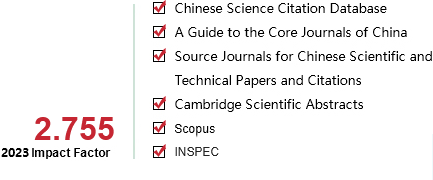[1]ZHU Jun,ZHENG Wendong,GE Quanbo,et al.Dynamic imaging of touch tracking based on multi-frame reconstruction in electrical impedance tomography[J].CAAI Transactions on Intelligent Systems,2024,19(6):1458-1467.[doi:10.11992/tis.202308027]
Copy
Dynamic imaging of touch tracking based on multi-frame reconstruction in electrical impedance tomography
CAAI Transactions on Intelligent Systems[ISSN 1673-4785/CN 23-1538/TP] Volume:
19
Number of periods:
2024 6
Page number:
1458-1467
Column:
学术论文—智能系统
Public date:
2024-12-05
- Title:
- Dynamic imaging of touch tracking based on multi-frame reconstruction in electrical impedance tomography
- Keywords:
- electrical impedance tomography; tactile sensing; touch tracking; multi-frame; image reconstruction; dynamic imaging; trajectory writing; human-machine interaction
- CLC:
- TP391
- DOI:
- 10.11992/tis.202308027
- Abstract:
- Touch sensing is of considerable importance to human–machine interaction. A touch interaction method integrating electrical impedance tomography (EIT) is proposed to enhance the real-time responsiveness and accuracy of touch sensing in human–machine interaction. This method employs a dynamic image reconstruction approach based on multiple data frames to construct a multiframe regularization model and fully mine the temporal correlation information between adjacent frames. An EIT-based resistive tactile sensing system is also designed to validate the effectiveness of this method. The system, which features a multilayer composite structure, responds to changes in touch pressure in real time. Experiments are conducted to discretely and continuously measure touch pressure and track touch points. Experimental results indicate that, compared with traditional single-frame static imaging methods, the proposed multiframe reconstruction algorithm notably reduces the positional error, deformation, and artifacts in the reconstructed images during motion, achieving a higher degree of conformity with the actual touch positions. This approach offers a promising solution for touch sensing in the field of human–machine interaction.
- References:
-
[1] EROL A, BEBIS G, NICOLESCU M, et al. Vision-based hand pose estimation: a review[J]. Computer vision and image understanding, 2007, 108(1/2): 52-73.
[2] MITRA S, ACHARYA T. Gesture recognition: a survey[J]. IEEE transactions on systems, man, and cybernetics, part C (applications and reviews), 2007, 37(3): 311-324.
[3] BERMAN S, STERN H. Sensors for gesture recognition systems[J]. IEEE transactions on systems, man, and cybernetics, part C (applications and reviews), 2012, 42(3): 277-290.
[4] WU Chenning, SOLEIMANI M. In-water handwriting in multi-medium using electrical impedance imaging[J]. IOP SciNotes, 2020, 1(2): 025001.
[5] CHENG Jingyuan, SUNDHOLM M, ZHOU Bo, et al. Smart-surface: large scale textile pressure sensors arrays for activity recognition[J]. Pervasive and mobile computing, 2016, 30: 97-112.
[6] YOON S H, HUO Ke, ZHANG Yunbo, et al. iSoft: a customizable soft sensor with real-time continuous contact and stretching sensing[C]//Proceedings of the 30th Annual ACM Symposium on User Interface Software and Technology. Québec: ACM, 2017: 665–678.
[7] ZHANG Yang, LAPUT G, HARRISON C. Electrick: low-cost touch sensing using electric field tomography[C]//Proceedings of the 2017 CHI Conference on Human Factors in Computing Systems. Denver: ACM, 2017: 1–14.
[8] ZHANG Yang, HARRISON C. Pulp nonfiction: low-cost touch tracking for paper[C]//Proceedings of the 2018 CHI Conference on Human Factors in Computing Systems. Montreal: ACM, 2018: 1–11.
[9] PARK K, PARK H, LEE H, et al. An ERT-based robotic skin with sparsely distributed electrodes: structure, fabrication, and DNN-based signal processing[C]//2020 IEEE International Conference on Robotics and Automation. Paris: IEEE, 2020: 1617-1624.
[10] PARK H, PARK K, MO S, et al. Deep neural network based electrical impedance tomographic sensing methodology for large-area robotic tactile sensing[J]. IEEE transactions on robotics, 2021, 37(5): 1570-1583.
[11] ZHENG Enhao, LI Yuhua, ZHAO Zhiyu, et al. An electrical impedance tomography based interface for human–robot collaboration[J]. IEEE/ASME transactions on mechatronics, 2021, 26(5): 2373-2384.
[12] BARBER D C, BROWN B H. Applied potential tomography[J]. Journal of the British interplanetary society, 1989, 42(7): 391-393.
[13] VAUHKONEN M, VADáSZ D, KARJALAINEN P A, et al. Tikhonov regularization and prior information in electrical impedance tomography[J]. IEEE transactions on medical imaging, 1998, 17(2): 285-293.
[14] ADLER A, GUARDO R. Electrical impedance tomography: regularized imaging and contrast detection[J]. IEEE transactions on medical imaging, 1996, 15(2): 170-179.
[15] GOLDSTEIN T, OSHER S. The split bregman method for L1-regularized problems[J]. SIAM journal on imaging sciences, 2009, 2(2): 323-343.
[16] MA Gang, CHEN Haofeng, WANG Peng, et al. Multi-frame constrained block sparse Bayesian learning for flexible tactile sensing using electrical impedance tomography[J]. IEEE transactions on computational imaging, 2022, 8: 438-448.
[17] ADLER A, ARNOLD J H, BAYFORD R, et al. GREIT: a unified approach to 2D linear EIT reconstruction of lung images[J]. Physiological measurement, 2009, 30(6): S35-S55.
[18] ADLER A, LIONHEART W R B. Uses and abuses of EIDORS: an extensible software base for EIT[J]. Physiological measurement, 2006, 27(5): S25-S42.
[19] ZHENG Wendong, LIU Huaping, GUO Di, et al. Adaptive optimal electrical resistance tomography for large-area tactile sensing[C]//2023 IEEE International Conference on Robotics and Automation. London: IEEE, 2023: 10338-10344.
[20] CHEN Bo, ABASCAL J F P J, SOLEIMANI M. Extended joint sparsity reconstruction for spatial and temporal ERT imaging[J]. Sensors, 2018, 18(11): 4014.
[21] BOYLE A, ARISTOVICH K, ADLER A. Beneficial techniques for spatio-temporal imaging in electrical impedance tomography[J]. Physiological measurement, 2020, 41(6): 064003.
[22] CHENEY M, ISAACSON D, NEWELL J C, et al. NOSER: an algorithm for solving the inverse conductivity problem[J]. International journal of imaging systems and technology, 1990, 2(2): 66-75.
[23] ADLER A, DAI Tao, LIONHEART W R B. Temporal image reconstruction in electrical impedance tomography[J]. Physiological measurement, 2007, 28(7): S1-S11.
[24] GAGNON H, GRYCHTOL B, ADLER A. A comparison framework for temporal image reconstructions in electrical impedance tomography[J]. Physiological measurement, 2015, 36(6): 1093-1107.
[25] PARK K, KIM J. Neural-gas network-based optimal design method for ERT-based whole-body robotic skin[J]. IEEE transactions on robotics, 2022, 38(6): 3463-3478.
[26] PEDREGOSA F, VAROQUAUX G, GRAMFORT A, et al. Scikit-learn: machine learning in python[J]. Journal of machine learning research, 2011, 12: 2825-2830.
- Similar References:
Memo
-
Last Update:
2024-11-05
